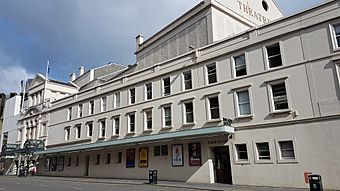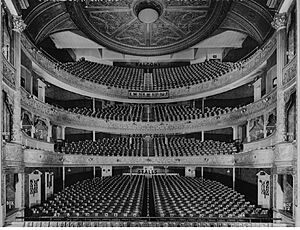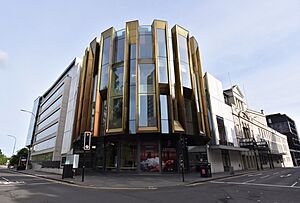Theatre Royal, Glasgow facts for kids
|
Royal Colosseum Theatre and Opera House
|
|
 |
|
| Address | 282 Hope Street Glasgow Scotland |
|---|---|
| Owner | James Baylis (1867-1870) Baylis Trust (1870-1877) Margaret Anderson family (1877-1888) James Howard and Fred Wyndham (1888-1895) Howard & Wyndham Ltd (1895-1957) Scottish Television (1957-1974) Scottish Opera (1974 – present) |
| Type | Proscenium |
| Capacity | 1,541 |
| Construction | |
| Opened | 1867 |
| Renovated | 2014 |
| Rebuilt | 1879 1895 |
| Architect | William Clarke and George Bell Charles J. Phipps |
| Website | |
| Official Box Office: https://www.atgtickets.com/venues/theatre-royal-glasgow/ | |
The Theatre Royal is the oldest theatre in Glasgow, Scotland. It has been open longer than any other theatre in the country. Located at 282 Hope Street, it can hold 1,541 people. Today, Scottish Opera owns the theatre. It first opened in 1867 and became known as the Theatre Royal two years later. This theatre is also where a big company called Howard & Wyndham Ltd started. They owned and managed many theatres in Scotland and England for a long time.
Contents
History of the Theatre Royal
Early Years and First Fire
The theatre first opened in 1867. It was called the Royal Colosseum and Opera House. A man named James Baylis started it. He also ran other music halls in Glasgow. The theatre was designed by George Bell. He was a famous architect in Glasgow.
In its early days, the theatre showed many different types of performances. These included pantomimes, plays, comedies, and opera. It's interesting that opera was performed so early, as the theatre later became the home of Scottish Opera. Many operas had their first performance in Scotland at the Theatre Royal.
In 1869, Baylis leased the theatre to Glover & Francis. They had run the old Theatre Royal on Dunlop Street. That theatre was torn down to build St Enoch railway station. William Glover brought the name "Theatre Royal" with him to the new building. His company performed drama, opera, and pantomime.
Rebuilding and New Owners
In 1879, a fire sadly destroyed the inside of the theatre. It was rebuilt by a famous theatre architect named Charles J. Phipps. He gave it the beautiful French Renaissance style you see today. The new design added more seating levels. The main entrance was also moved to Hope Street. The theatre could still hold about 3,000 people. It is now the largest example of Charles Phipps' theatre work still standing in Britain.
In the 1880s, different managers ran the theatre. Then, in 1888, two actor-managers, James Howard and Fred Wyndham, took over. They decided the theatre would be famous for pantomimes. Their first pantomime was "The Forty Thieves." Their new company, Howard & Wyndham, produced pantomimes across Britain for nearly 80 years.
In 1895, Howard & Wyndham became a big company called Howard & Wyndham Ltd. They owned and ran many top theatres in Scotland and England. The Theatre Royal was their most important theatre. In the same year, another fire destroyed the inside of the theatre. But it was rebuilt quickly, just six months later, again by Charles Phipps. Howard & Wyndham Ltd also built the King’s Theatre in Glasgow in 1904.
A Home for TV and Opera
In 1957, Scottish Television (STV) bought the Theatre Royal. They turned it into a TV studio and offices. Live music, dance, and comedy shows were filmed here. These shows were broadcast across Scotland and to other parts of the UK. STV also helped Scottish Opera, which started in 1962.
On November 3, 1969, another fire broke out at the theatre. Sadly, a firefighter died trying to put it out. STV moved most of its shows to its Edinburgh studio for a short time.
In 1974, Scottish Television moved to a new building next door. They offered the Theatre Royal to Scottish Opera. Scottish Opera bought it with public support. They turned it into Scotland's first national opera house. The theatre had a big renovation. This included a larger entrance area, a new main staircase, and a bigger orchestra pit. The dressing rooms were also updated. The inside of the theatre was restored to its original look. It had cream and gold colours with pale blue on the ceiling. It reopened in October 1975 with a special performance of Die Fledermaus.
The Duke of Edinburgh officially opened the newly refurbished Theatre Royal in October 1975. He spent the day meeting the people who worked on the theatre.
A few months later, the Theatre Royal also became the home of Scottish Ballet. It was also a main venue for the Mayfest Festival each year. Since 1977, it has been a category A listed building. This means it is very important for its architecture and history.
Modern Updates
In 1997, money from the lottery helped pay for more updates. The theatre was rewired and redecorated. In 2005, Scottish Opera leased the theatre's management to the Ambassador Theatre Group. However, the Theatre Royal is still the main place for performances by Scottish Opera and Scottish Ballet.
From 2012, with funding from the Scottish Government and others, Scottish Opera built new entrance areas. These new foyers opened in December 2014. They are a large, round building with new entrances, bars, a cafe, and spaces for education. There are also lifts to all levels and a spiral staircase.
The architects, Page & Park, wanted to make the corner of Hope Street and Cowcaddens Road special. They said it would be like "a little bit of the splendid interior has escaped." They wanted it to be a fun building to visit.
The theatre also has Young Theatre Royal. These are classes for young people aged 3–18. They are run with Showworks Theatre.
See also
 In Spanish: Real teatro de Glasgow para niños
In Spanish: Real teatro de Glasgow para niños
- Culture in Glasgow
- List of Category A listed buildings in Glasgow
- List of theatres in Scotland
- List of opera houses
- Theatre Royal disaster (1849, Dunlop Street building)



